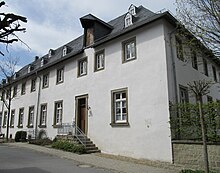Capuchin monastery Rüthen
The Rüthen Capuchin Monastery was established in 1654 and existed until it was abolished in 1804 in the course of secularization in the Duchy of Westphalia .
history
In 1651 the Capuchins got permission to settle in Rüthen . In 1654 it was founded as the monastery of St. Catharina and St. Elisabeth.
The baroque monastery church made of Rüthener sandstone was built by Ambrosius von Oelde around 1683 . The exact appearance of the church is no longer known. The building probably resembled the usual Capuchin churches as a single-nave hall church with a retracted choir. The monastery itself had three wings and was laid out around a cloister.
The construction was largely financed by Johann Adolf von Fürstenberg . The community had a noteworthy monastery library, although precise information is not available.
After the abolition of the monastery in 1804, Minorites from Brilon still settled in the monastery until 1808 . The church was demolished around 1834. Only the portal remained and is now used as the entrance to the city cemetery. The rest of the monastery complex was used, among other things, as a district court.
Picture gallery
Individual evidence
- ↑ Monastery portal and donors ( Memento from April 2, 2008 in the Internet Archive )
literature
- Géza Jászai (Ed.): Monastic Westphalia. Monasteries and monasteries 800–1800. Westfälisches Landesmuseum für Kunst und Kulturgeschichte, Münster 1982, ISBN 3-88789-054-X , p. 423 (exhibition catalog, Münster, Westfälisches Landesmuseum für Kunst und Kulturgeschichte, September 26, 1982 - November 21, 1982).
Web links
- Haas: Capuchins in Rhineland and Westphalia ... (PDF file; 1008 kB)
Coordinates: 51 ° 29 ′ 27 " N , 8 ° 25 ′ 52.6" E



